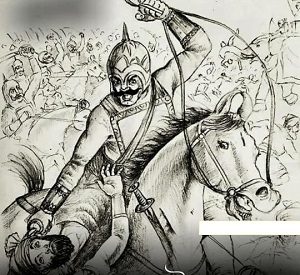After the fall of the great Rajput king Prithviraj III, Indian resistance to Arabs and Turks finally ended after resisting for 500 years.
Rai Pithora or Prithviraj III fought audaciously in the second battle of Tarain. It was the treachery that changed the course of the battle.

Before the battle, Mohammed Ghori made a night attack on the camp of the Rajputs. Ghori was aware of the fact that the Rajput followed the code of Dharmayuddha. The mounted Turkish bowmen caught the Rajputs completely unprepared.
This attack cause much damage to the Rajputs but still, the Rajputs of Prithviraj Chauhan didn’t back down and fought the remaining battle with all force.
In the end, the Turks won the battle, and the Hindu king Prithviraj III attained martyrdom fighting for his people and kingdom.

For the first time, Turks penetrated into the Indian subcontinent and founded their rule over Delhi. But this was not the end for the Indians as under the dauntless leadership of the Mhers community and Chalukya of Gujarat (under Bhima II) the advance of the Turks was halted by the Indians.
Content
Revival of Hindu Power: Rise of Mhers
But the audacious spirit of the Indians was suddenly revitalized by the Mhers at Ajmer. The brave Prithviraj III and his brother Hariraja died heroic deaths but they had infused courage in the hearts of people to continue the Hindu struggle against the mlecchas.
The forces of the Slave Sultanate at Ajmer were closely checked by the Mhers. The Mhers also initiated to gather the support of Chalukya Rajput king Bhima II of Gujarat. These were the same Chalukya’s who crushed Mohammad Ghori in 1178 and due to this, the Mhers find some inspiration from them.
They wanted to find the loopholes on the Turushka and wanted to launch a surprise attack on the Turks at Ajmer and block their supply routes. But the slave sultan i.e. Qutub-ud-din got the news of this attack and in return, the Qutub-ud-din attacked the Mhers at Ajmer with a huge army.
The Forgotten Defeat of Qutub ud din Aibak
The battle (around 1195) took place in the early morning in which the heavily outnumbered Mhers bravely resisted the sultanate attack. The battle lasted for the whole day which gives us glimpses of Mhers bravery.

The next day the allies of Mhers i.e. the Chalukya of Gujarat arrived with massive forces from Anhilwara. By now the Turks who were already facing difficulty in eradicating Mhers suddenly found themselves surrounded by the Chaulkya’s of Gujarat.
The battle resulted in a total disaster for the Turks. A large number of turushka were massacred and their commander was heavily wounded and retreated from the battlefield. The Turks in order to save their commander took the latter to Ajmer fort.
But the gallant Mher didn’t back down. They decided to chase the fleeing army of Turks and later they were successful in surrounding Qutub ud din Aibak. Qutub ud din sent a pleading message all way back to Ghazni for immediate reinforcement. The result of this request was successful and later a large army from Ghazni arrived to aid Qutub ud din.
Due to the arrival of fresh troops, Mhers decided to follow a tactical move and withdrew from the field. But this humiliation always haunted Qutub ud din and the slave sultan of Delhi Sultanate wanted to avenge this defeat as soon as possible.
Hasan Nizami the Persian historian during the time of the Delhi Sultanate also confirms this disaster suffered by the Qutub ud din Aibak. According to him, many Turks perished in the battles, and Aibak although fought audaciously got wounded and retreated towards Agra where the Mhers and Chalukya army chased them.
Qutub ud din and the Chalukyas Rajputs
In 1196- 1197 Qutub ud din packed his hordes and marched towards Anahilapataka. The ruler of Gujarat i.e. Bhima II entrusted Karna Deva and Dharavarsha Paramara of the Vaghela Dynasty.
The Hindu army made a psychological move and assembled themselves at the foot of Mount Abu. This was the same location where Mohammad Ghori was thrashed by Naiki Devi and others.
When Aibak arrived at Mount Abu they didn’t dare to attack the Hindu army as they believed the placed to a curse for them.
Later both armies came into the open field and a titanic encounter took place. The battle was so severe that it lasted for the whole day. Unfortunately this time the result was not in favor of the Hindus and they lost the battle.
Around 50,000 people died in this battle according to contemporary sources. From here the Turks marched on towards Anahilapataka. The Sultan and his army crossed all limits of barbarism and demolish temples, villages, and cities.
Many were taken as prisoners too. Aibak placed his officer there for future confrontation. But this was not the end and the Hindus rose again. When Aibak left Anahilapataka Bhima II wasted no time in eradicating the Turks from his territories. The region of Gujarat became independent thanks to king Bhima II.
For the next century, Gujarat remained independent and the Sultans of Delhi never dared to attack this land. This was a short but inspiring story of those heroes who relentlessly fought for the protection of their land from foreign invaders.
Why this heroic tale of Hindu heroes is missing from our textbook we can only imagine?
Donate to our Cause
If you support what we are doing and would like to contribute to help us grow and reach more Indians to teach them more about such forgotten historic Indian Heroes and stories, please consider donating any amount. It will help us grow

